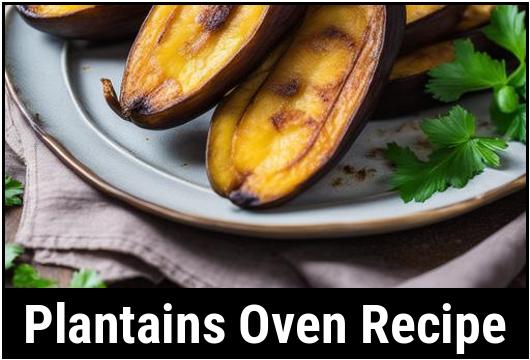
Plantains Oven Recipe: A Comprehensive Guide
Plantains are a staple food in many tropical regions, beloved for their versatility and delicious flavor. While they can be cooked in various ways, baking them in the oven is a simple and convenient method that brings out their natural sweetness and creates a delightful caramelized exterior. In this article, we will explore the science behind cooking plantains in an oven, discuss how to select the best ingredients, provide detailed instructions for preparation, and guide you through the optimal temperature and timing for achieving perfect results. Finally, we’ll present a mouthwatering oven recipe for plantains that is sure to impress your taste buds.
Food Science Of Cooking Plantains In An Oven
Understanding the science behind cooking plantains in an oven can help you achieve the perfect texture and flavor. Plantains are a type of banana, but unlike the sweet bananas typically eaten raw, plantains are starchy and less sweet when ripe. When exposed to heat, the starches in plantains undergo complex chemical reactions that transform their texture and flavor.
The key to baking plantains in the oven is to use the right temperature and timing to achieve the desired outcome. At higher temperatures, the sugars in the plantains caramelize, creating a golden-brown crust and enhancing their natural sweetness. However, cooking at too high a temperature can cause the sugars to burn before the interior is fully cooked.
Additionally, the ripeness of the plantains will affect the final result. Ripe plantains, which have a yellow or black peel, are sweeter and softer, making them ideal for baking. Green or yellow-green plantains are less sweet and more firm, making them better suited for frying or boiling.
Choosing Ingredients
Selecting the right ingredients is essential for making delicious oven-baked plantains. Here’s what you’ll need:
-
Plantains: Choose ripe plantains with yellow or black peels. Avoid green plantains, as they will be too firm and not as sweet.
-
Oil: Use a neutral oil with a high smoke point, such as vegetable oil or coconut oil, for brushing the plantains before baking. This helps them brown evenly and prevents them from drying out.
-
Optional Seasonings: While plain baked plantains are delicious on their own, you can add extra flavor with seasonings such as cinnamon, nutmeg, or chili powder. Experiment with different spices to create unique flavor combinations.
Preparing Ingredients
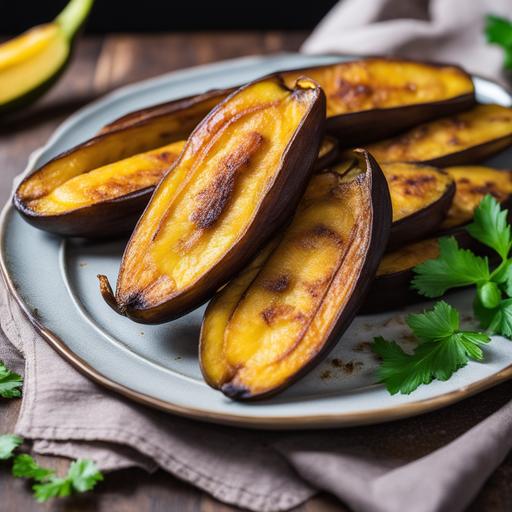
Before baking, it’s important to properly prepare the plantains. Follow these steps:
-
Peel the Plantains: Start by peeling the plantains. Cut off both ends, then make a slit along the length of the peel. Use your fingers to peel away the skin.
-
Slice the Plantains: Once peeled, slice the plantains into evenly sized pieces. You can slice them into rounds or lengthwise into quarters, depending on your preference.
-
Brush with Oil: Lightly brush the plantain slices with oil on both sides. This will help them brown evenly and prevent them from sticking to the baking sheet.
Optimal Oven Cooking Temperature & Timing
To achieve perfectly baked plantains, it’s essential to use the right oven temperature and timing. Preheat your oven to 375°F (190°C) for best results. Baking at this temperature allows the plantains to cook evenly and caramelize on the outside without burning.
Place the prepared plantain slices on a baking sheet lined with parchment paper or a silicone baking mat, making sure they are spaced apart to allow for even cooking. Bake in the preheated oven for 20-25 minutes, flipping the slices halfway through, until they are golden brown and tender.
Keep an eye on the plantains towards the end of the baking time to prevent them from overcooking. They should be soft and caramelized on the outside but still firm enough to hold their shape.
Plantains Oven Recipe
Now that you understand the science and technique behind baking plantains in the oven, let’s dive into a delicious recipe:
Ingredients
- 3 ripe plantains
- 2 tablespoons vegetable oil
- Optional seasonings (such as cinnamon or chili powder)
Instructions
-
Preheat your oven to 375°F (190°C) and line a baking sheet with parchment paper or a silicone baking mat.
-
Peel the plantains and slice them into evenly sized pieces.
-
Place the plantain slices on the prepared baking sheet and brush them with vegetable oil on both sides.
-
If desired, sprinkle the plantain slices with your choice of seasonings, such as cinnamon or chili powder, for extra flavor.
-
Bake the plantains in the preheated oven for 20-25 minutes, flipping them halfway through, until they are golden brown and tender.
-
Once baked, remove the plantains from the oven and let them cool slightly before serving.
-
Enjoy your delicious oven-baked plantains as a snack, side dish, or dessert!
Baking plantains in the oven is a simple and flavorful way to enjoy this versatile tropical fruit. By understanding the science behind cooking plantains and following our detailed instructions, you can achieve perfectly caramelized and tender plantains every time. Experiment with different seasonings and serving options to customize this recipe to your taste preferences. Whether enjoyed as a snack, side dish, or dessert, oven-baked plantains are sure to delight your taste buds and impress your guests.
Doneness Checks
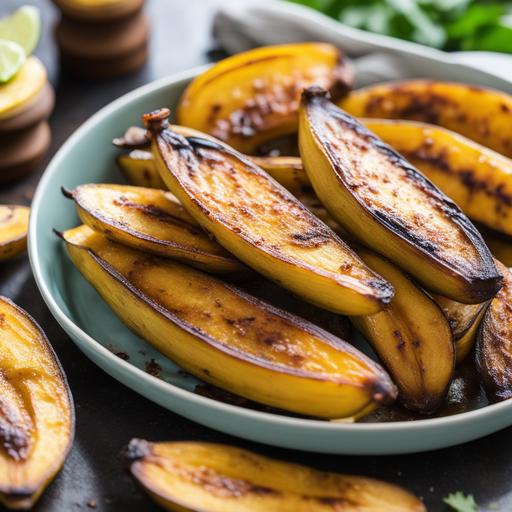
Plantains, often mistaken for bananas, are a starchy fruit belonging to the banana family. Unlike bananas, plantains are typically cooked before consumption due to their high starch content and lower sugar levels. Baking plantains in the oven enhances their natural sweetness while maintaining a satisfyingly tender texture.
The process of baking plantains is relatively straightforward, requiring minimal ingredients and equipment. With a few simple steps, you can transform firm, green plantains into golden, caramelized delights that are perfect as a side dish, snack, or dessert.
Determining the optimal level of doneness is crucial when baking plantains to achieve the desired texture and flavor. Several indicators can help gauge when plantains are perfectly baked:
1. Color
Monitor the color transformation of the plantains as they bake. Green plantains will gradually turn yellow, indicating ripeness, while ripe plantains will develop a deep golden hue. Aim for a uniformly golden-brown color across the surface of the plantains, signaling caramelization and tenderness.
2. Texture
The texture of baked plantains evolves during the baking process. Initially firm and starchy, plantains soften as they bake, becoming tender and creamy on the inside while developing a slightly crisp exterior. Test the plantains with a fork or knife to ensure they are soft and yielding.
3. Aroma
Pay attention to the aroma emanating from the oven as the plantains bake. A sweet, caramel-like fragrance indicates that the sugars in the plantains have caramelized, enhancing their natural sweetness and flavor.
Undercooking
Undercooking plantains can result in a lack of tenderness and sweetness, leaving them unappealing and overly starchy. To prevent undercooking, follow these tips:
-
Preheating the Oven: Ensure that the oven is preheated to the recommended temperature before placing the plantains inside. Preheating allows for even cooking and caramelization.
-
Proper Slicing: Cut the plantains into evenly sized pieces to promote uniform cooking. Thicker slices may require additional baking time to fully cook through.
-
Checking for Softness: Test the plantains for softness using a fork or knife. If they still feel firm and resistant, continue baking until they reach the desired tenderness.
Overcooking
Overcooking plantains can lead to burnt edges, excessive caramelization, and a mushy texture. To avoid overcooking, consider the following precautions:
-
Monitoring Closely: Keep a close eye on the plantains as they bake to prevent them from becoming overly browned or burnt. Adjust the baking time as needed to achieve the desired level of caramelization.
-
Using Proper Temperature: Bake the plantains at the recommended temperature specified in the recipe. Higher temperatures can cause the sugars to caramelize too quickly, resulting in uneven cooking and potential burning.
-
Removing Promptly: Once the plantains are adequately baked, remove them from the oven promptly to prevent further cooking and browning. Transfer them to a cooling rack or serving dish to allow them to cool slightly before serving.
Troubleshooting
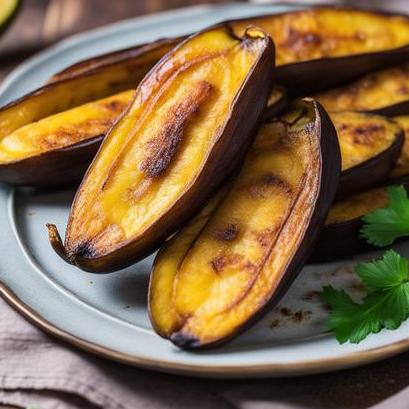
Encountering issues while baking plantains is not uncommon, but with a few troubleshooting techniques, you can salvage your dish and achieve delicious results:
1. Uneven Browning
If the plantains exhibit uneven browning, rotate the baking sheet halfway through the cooking process. This ensures that all sides of the plantains are exposed to the heat evenly, promoting uniform caramelization.
2. Excessive Browning
If the plantains are browning too quickly on the outside while remaining undercooked inside, tent the baking sheet with aluminum foil. This helps to shield the plantains from direct heat while allowing them to continue cooking until tender.
3. Tough Texture
If the baked plantains turn out tough or rubbery, they may have been underripe. To salvage them, return the plantains to the oven and continue baking at a lower temperature until they soften to the desired texture.
Recipe Variations
Baking plantains in the oven opens up a world of possibilities for culinary creativity. Experiment with various flavors, toppings, and cooking methods to customize your plantain dish. Here are some recipe variations to inspire your culinary adventures:
1. Sweet And Spicy Plantains
Coat the plantain slices with a mixture of honey, cinnamon, and chili powder before baking for a sweet and spicy flavor profile. Serve as a side dish or dessert topped with a dollop of whipped cream or vanilla ice cream.
2. Savory Plantain Chips
Slice the plantains thinly and toss them with olive oil, salt, and garlic powder. Arrange the slices in a single layer on a baking sheet and bake until crispy for homemade plantain chips. Enjoy as a crunchy snack or serve alongside your favorite dips.
3. Stuffed Plantains
Cut a slit along the length of each plantain and stuff them with a savory filling such as seasoned ground beef, black beans, and cheese. Bake until the plantains are tender and the filling is heated through for a satisfying main course or appetizer.
Oven-baked plantains offer a nutritious and delicious addition to any meal, whether as a side dish, snack, or dessert. By mastering the art of baking plantains, you can unlock their full potential and enjoy their natural sweetness and versatility. With careful attention to doneness checks, troubleshooting techniques, and recipe variations, you can create mouthwatering plantain dishes that will impress your family and friends. So, preheat your oven, grab some ripe plantains, and embark on a culinary journey filled with flavor and satisfaction. Bon appétit!
Flavour Enhancement Tips
Plantains, often mistaken for bananas, are a staple food in many tropical regions around the world. Unlike bananas, plantains are typically larger and starchier, making them suitable for cooking in various ways. Baking plantains in the oven is a popular method that requires minimal effort but yields impressive results.
Before diving into the recipe, it’s essential to understand the difference between ripe and unripe plantains. Ripe plantains have yellow or black skins and are sweeter, similar to bananas. Unripe plantains, on the other hand, have green skins and are firmer and less sweet. Both types can be used for oven baking, but the level of ripeness will affect the final taste and texture.
Enhancing the flavor of oven-baked plantains can elevate the dish from ordinary to extraordinary. Here are some tips to help you achieve maximum flavor:
1. Ripeness Matters
The ripeness of the plantains significantly impacts their flavor. Ripe plantains with yellow skins will be sweeter and have a more pronounced banana-like taste. If you prefer a sweeter dish, opt for fully ripe plantains. However, if you prefer a slightly savory flavor, unripe plantains with green skins will work well too.
2. Seasonings And Spices
Adding seasonings and spices can enhance the natural sweetness of the plantains and add depth to the flavor profile. Common options include cinnamon, nutmeg, cloves, and ginger. You can also experiment with savory spices like paprika, cumin, or chili powder for a more complex flavor profile.
3. Sweeteners
While ripe plantains are naturally sweet, you can further enhance their sweetness by drizzling them with honey, maple syrup, or brown sugar before baking. This adds a caramelized glaze to the plantains and intensifies their flavor.
Texture Enhancement Tips
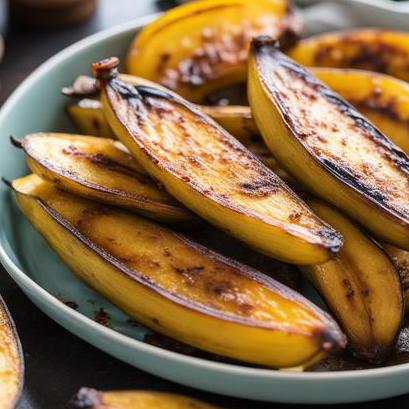
Achieving the perfect texture is key to making oven-baked plantains irresistible. Follow these tips to ensure your plantains turn out tender on the inside and caramelized on the outside:
1. Slicing Technique
The way you slice the plantains can affect their texture after baking. For softer, melt-in-your-mouth plantains, slice them into thicker pieces. Thinner slices will result in a crispier texture, similar to plantain chips.
2. Baking Temperature
The temperature at which you bake the plantains can also influence their texture. Baking at a higher temperature (around 400°F/200°C) will result in a crispier exterior, while baking at a lower temperature (around 350°F/175°C) will yield softer, more tender plantains.
3. Oil Or Butter
Coating the plantains in oil or butter before baking helps them retain moisture and promotes caramelization. Use a neutral oil like vegetable or coconut oil, or opt for butter for added richness.
Cooking At Different Temperatures
The cooking temperature plays a crucial role in the outcome of oven-baked plantains. Here’s how different temperatures affect the final result:
1. High Temperature (400°F/200°C)
Baking plantains at a high temperature results in a quicker cooking time and a crispy exterior. This method is ideal for achieving caramelization and a slightly crunchy texture. However, be mindful not to overcook the plantains, as they may become too dry.
2. Moderate Temperature (350°F/175°C)
Baking plantains at a moderate temperature allows them to cook more slowly and evenly, resulting in a softer texture with a caramelized exterior. This method is preferable if you prefer tender, melt-in-your-mouth plantains.
Cooking Tips
To ensure success when baking plantains in the oven, consider the following tips:
1. Use Ripe Plantains
Choose plantains that are ripe but still firm for the best flavor and texture. Avoid using overly ripe plantains with black skins, as they may become too mushy when baked.
2. Preheat The Oven
Always preheat your oven before baking the plantains to ensure even cooking and proper caramelization.
3. Line The Baking Sheet
Line a baking sheet with parchment paper or aluminum foil to prevent the plantains from sticking and make cleanup easier.
4. Flip Halfway Through
For even browning, flip the plantains halfway through the baking time using a spatula or tongs.
5. Serve Immediately
Oven-baked plantains are best served hot out of the oven. Enjoy them as a standalone snack or as a side dish with your favorite meal.
Serving Suggestions
Oven-baked plantains can be served in various ways, depending on your preferences and the occasion:
1. Side Dish
Serve baked plantains as a side dish alongside grilled meat, fish, or poultry. They pair well with savory dishes and add a touch of sweetness to the meal.
2. Dessert
Top baked plantains with a scoop of vanilla ice cream or whipped cream for a simple yet delicious dessert. Drizzle with caramel sauce or sprinkle with cinnamon for added flavor.
3. Snack
Enjoy oven-baked plantains as a wholesome snack on their own or with a dipping sauce such as yogurt, chocolate sauce, or peanut butter.
Conclusion
Oven-baked plantains are a delightful treat that showcases the natural sweetness and versatility of this tropical fruit. By following the tips outlined in this article, you can create perfectly caramelized plantains with tender, melt-in-your-mouth interiors. Experiment with different seasonings, spices, and serving options to customize the dish to your liking. Whether enjoyed as a side dish, dessert, or snack, oven-baked plantains are sure to satisfy your cravings and impress your taste buds.
FAQS
Can Plantains Be Baked In The Oven?
Yes, plantains can be easily baked in the oven to achieve a delicious and crispy texture.
How Do I Choose The Right Plantains For Baking?
When selecting plantains for baking, look for those that are ripe but still firm. They should be yellow with some black spots or patches on the skin. Avoid using overly ripe or green plantains as they will affect the final texture and taste.
What Is The Best Way To Prepare Plantains For Baking?
To bake plantains, start by preheating the oven to 400°F (200°C). Lightly grease a baking sheet or line it with parchment paper. Peel the plantains and cut them into even-sized slices or halves, depending on your preference. Brush the plantains with some oil to enhance browning and prevent sticking.
How Long Should I Bake Plantains And At What Temperature?
Bake the plantains in the preheated oven for about 25-30 minutes or until they turn golden brown. For an even bake, flip the plantains halfway through the cooking time. Adjust the baking time accordingly if you prefer softer or firmer plantains.
Can I Season The Plantains Before Baking?
Absolutely! Before placing the plantains in the oven, you can sprinkle them with salt, pepper, cinnamon, or any other desired seasoning to add extra flavor. Additionally, you can also drizzle some honey, maple syrup, or melted butter for a touch of sweetness. Just be mindful of the seasoning combinations to achieve the desired taste.


